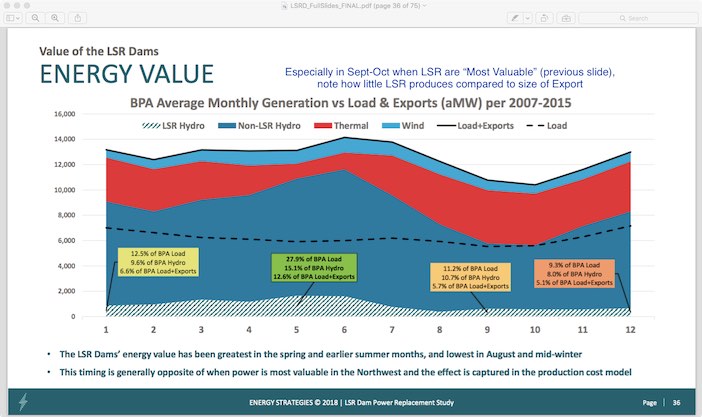forum
library
tutorial
contact

Breach Snake River Dams
by Luan PinsonHood River News, May 22, 2019
|
the film forum library tutorial contact |

|
Breach Snake River Damsby Luan PinsonHood River News, May 22, 2019 |
Since the LSR dams only produce 3 to 4 percent of total Pacific Northwest energy, midst a surplus
of at least 17 to 24 percent, the LSR dam's 3-4 percent is already unneeded -- it's surplus energy.
 Can we save Snake River salmon runs? That question is linked to this one: Can we save Bonneville Power Administration? And: Does it make sense to breach the Lower Snake River (LSR) dams to save both?
Can we save Snake River salmon runs? That question is linked to this one: Can we save Bonneville Power Administration? And: Does it make sense to breach the Lower Snake River (LSR) dams to save both?
Under average river flows, the Pacific Northwest has an estimated 24 percent energy surplus. Under what Bonneville Power Administration considers "critical water conditions," that is, the past 100-years' lowest water levels. Surplus Pacific Northwest energy sits at 17 percent.
In part due to having to sell that surplus power at ever lower prices, even at a loss, BPA Administrator Elliot Mainzer has recently acknowledged that BPA is financially in crisis.
The Corps of Engineers says the lower Snake dam turbines have a life expectancy of 35 to 45 years. By 2030, nine of the LSR turbines will be over 60 years old, and 12 others 50-60 years old. Cost of rehabs of all the turbines: Over $1 billion. Since the LSR dams only produce 3 to 4 percent of total Pacific Northwest energy, midst a surplus of at least 17 to 24 percent, the LSR dam's 3-4 percent is already unneeded -- it's surplus energy.
Shedding itself of these four dams could very well save, not only fish, but BPA from "extinction."
learn more on topics covered in the film
see the video
read the script
learn the songs
discussion forum
